Distinguishing age spots from skin cancer: A guide for identifying the variations
Serving up the Skin Scoop: Age Spots and Cancer
As we age, our skin plays host to a variety of marks, some of which can be mistaken for cancer. Let's explore the distinctions between age spots and skin cancer, along with their symptoms, diagnoses, and treatments.
Age Spots or Sunspots: What's the Difference?
Age spots, also known as solar lentigines or liver spots, crop up as dark patches on your skin, typically from middle age onwards. They are generally flat, smooth, and flat, and they don't itch or feel scaly. Age spots appear due to the body producing excess melanin to protect the skin from sunlight.
Skin Cancer: A Condition to Watch Out For
Skin cancer, on the other hand, requires immediate medical attention. Like age spots, skin cancer is most likely to appear on sun-exposed areas, thanks to damage caused by UV rays. Skin cancer occurs when skin cells are damaged, leading to accelerated growth.
Identifying Your Spots
- Age Spot Symptoms: Age spots are usually flat, yellow, brown or gray, defined with clear borders, sizes ranging from a few millimeters to centimeters, and appear on sun-exposed areas.
- Skin Cancer Symptoms: Signs of a potential cancerous growth can include asymmetrical shape, irregular or ragged edges, multiple colors, and physical traits like pain, itching, crustiness, or bleeding. Actinic keratosis, a precancerous growth, might present as rough, red, scaly patches similar to age spots.
When to Contact a Doc
If you spot any skin changes that aren't usual for you, it's best to consult with a medical professional. Keep an eye out for signs of skin cancer, such as changes in color, shape, size, or location, or anything that itches, crusts, scabs, or doesn't heal within four weeks.
The Diagnosis Game
Doctors diagnose age spots through a physical examination, assessing appearance, texture, and placement. If needed, a skin biopsy may be carried out to test for skin cancer or actinic keratosis.
Treatments: Age Spots vs Skin Cancer
Age spots can be treated to reduce their appearance with options like creams and lotions, laser treatments, cryosurgery, microdermabrasion, and chemical peeling.
Skin cancer treatment depends on various factors, including type and stages. Options include surgical removal, topical therapies, radiation therapy, chemotherapy, immunotherapy, and systemic medication.
The Lowdown
Remember, age spots and skin cancer share some surface-level similarities but have distinct characteristics that can help you discern each condition. Be vigilant about changes in your skin, and consult with a healthcare professional if you have any concerns. Identifying skin cancer early paves the way for timely treatment and positive health outcomes.
- In the realm of dermatology, seniors should be particularly mindful of both age spots and skin cancer, two common skin conditions associated with aging and sun exposure.
- During medical-health examinations, doctors often use science-based diagnostic methods to assess and distinguish between age spots and skin cancer.
- Skin cancer, a serious medical-condition, requires prompt treatment, whereas age spots, while unsightly, can be managed with various skin-care treatments.
- It's essential to understand the differences between age spots and skin cancer, including symptoms and potential signs such as irregular shapes, multiple colors, pain, itching, or ongoing healing problems.
- Maintaining a regular health-and-wellness regimen, including timely skin checks with dermatologists, can help in early detection and treatment of both age spots and skin cancer, thereby contributing to overall skin-care and health.








